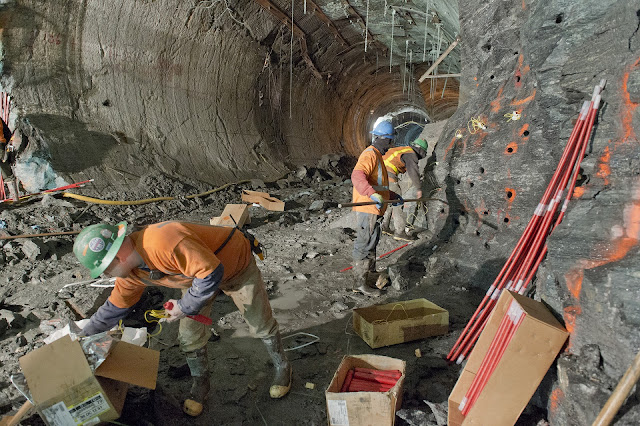This month it became public a new photographic update of the work on site - a work made by the photographer Patrick Cashin. All the photos presented above are property of Metropolitan Transportation Authority.
Text from the project's Wikipedia article (adapted):
"The project represents the construction effort to complete the line to Grand Central. After voters in New York approved a bond issue to provide state funds to the project, the federal government committed to provide $2.6 billion to help build the project by signing a Full Funding Grant Agreement in December 2006. The construction contract for a one-mile (two-kilometer) tunnel in Manhattan west and southward from the dormant lower level of the 63rd Street rail tunnel to the new station beneath Grand Central was awarded on July 13, 2006, to Dragados/Judlau, a joint American–Spanish venture (the American company is located in College Point, Queens). The total contract award is $430 million, and is using two large tunneling devices owned by the Spanish firm.
Dragados/Judlau created a launch chamber for tunnel-boring machines (TBM) under Second Avenue at 63rd Street using a controlled drill-and-blast method, then assembled and launched each 640-ton machine. The first TBM was launched west and southbound from the 63rd Street tunnel in September 2007 and reached Grand Central in July 2008. The second machine began boring a parallel tunnel in December 2007 and had completed its tunnel at 37th Street on September 30, 2008. Geocomp Corporation was hired to monitor the boring, using a battery of instruments to record vibration, ground settlement and any tilting or drift suffered by the TBM. The instruments include inclinometers, extensometers, seismographs, observation wells, dynamic strain gauges, tilt meters and automated motorized total stations (AMTS) with prismatic targets. The next step in construction is to back the TBMs out of the tunnels and cast-in-place concrete sections placed to create the lining. Each tunnel will be 22 feet (7 metres) in diameter and carry trains 140 feet (43 metres) beneath street level. The TBMs bored an average of 50 feet (15 metres) per day. Cross-connections between the tunnels are being created under Park Avenue, between 49th and 51st Streets, by controlled drill-and-blast.
In Queens, Pile Foundation Construction Company is building an $83 million open-cut and deck project, which is extending the tracks under Northern Boulevard into Sunnyside Yard, and creating an area that serves as both the launch chamber for soft-bore Queens tunnels, connecting the 63rd Street line to the main LIRR branches, and an interlocking and emergency exit and venting facility. Perini Corporation was awarded a $161 million contract to reconfigure Harold Interlocking, increasing its capacity to accommodate Grand Central-bound trains and accept new yard lead tracks to allow trains to enter the storage yards. On February 15, 2008, the MTA awarded Dragados-Judlau a $499 million contract to excavate the LIRR station and track wye caverns. On September 10, 2009, the MTA awarded Yonkers Contracting Company a $40.76 million contract to demolish a building at 44th Street and construct a ventilation plant and station entrance. On September 28, 2009, the MTA awarded Granite-Traylor-Frontiere Joint Venture a $659.2 million contract to employ two 500-ton slurry TBMs to create the tunnels which will connect the LIRR main line and the Port Washington Branch to the tunnel under 41st Avenue (the 63rd Street tunnel). Four tunnels, with precast concrete liners, will total two miles (three kilometers) in length. In March 2011, the MTA announced that these two TBMs would begin tunneling in April 2011.
On December 22, 2011, breakthrough was achieved in Tunnel "A" of the four Queens tunnel drives from the 63rd Street tunnel bellmouth. On July 25, 2012, all four Queens tunnel drives were complete."
Watch the September 2012's update of the work site on the video above. Other updates are available on Youtube, provided by MTA.

































No comments:
Post a Comment
Note: only a member of this blog may post a comment.